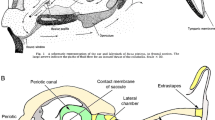Summary
-
I.
The labyrinth of the carp is a membraneous labyrinth the rostral part of which is the utriculus with the semicircular canals, the caudal part, the sacculus and the lagena which is closely connected with the latter.
-
II.
In the labyrinth, apart from smaller accessory and not constant stones, there usually are three bigger otholiths one of them is in the utriculus, one in the sacculus and one in the lagena. In the recessus utriculi of the utriculus we find the ovoid, convex, concave lapillus, in the sacculus the long thin three-edged sagitta and in the lagena the big spheric, on one border incised, flat asteriscus.
-
III.
The membraneous labyrinth is exclusively innervated by the nervus acusticus which divides after it leaves the medulla oblangata into two branches. One of them is the ramus anterior giving rise to three branches. These are the ramulus ampullae rostralis, ramulus ampullae lateralis and ramulus recessus utriculi. The other branch of the nervus acusticus is the ramus posterior, the branches of which are the ramulus sacculi, ramulus lagenae and ramulus ampullae caudalis. At the branching of the ramulus lagenae and ramulus ampullae caudalis there runs still a small branch the ramulus neglectus.
-
IV.
There are eight sensulae. Of these three are cristae and five maculae. The cristae are: the crista acustica ampullae rostralis, the crista acustica ampullae lateralis and the crista acustica ampullae caudalis. The maculae are: the macula acustica recessus utriculi, the macula acustica sacculi, the macula acustica lagenae, and the two maculae acusticae neglectae.
-
V.
The cristae acusticae are bodies bulging out from the wall of the ampullae, sinking deep into the lumen, bearing on the side of the lumen a relatively thick epithelial cap. This is really speaking the receptor organ. The fibres of the nervus acusticus end in this cap.
-
VI.
The maculae are different sized bulges consisting of a neuro-epithelium, proceeding gradually into the one layered cubic epithelium of the labyrinth.
-
VII.
The epithelium of the cristae consists of several rows of cylindrical epithelial cells, the components of which are the hair cells of the surface and basicly situated sustentacular cells, the upper tapering section penetrateing into the hair cells.
-
VIII.
On the base of the ramus anterior there is the longish flat ganglion vestibulare the cells of which are typical bipolar cells exhibiting in a distinctness which can not be observed elsewhere the neurofibrils.
-
IX.
The fibres running to the epithelium of the cristae are strikingly thick, thickening to a still greater extent in the lower part of the epithelium, this thickening is especially conspicious at the point where the fibres begin their very abundant arborization. At this point the single fibres turn into stumps exceeding manifold the original diameter of the fibres. The place of these stumps appear to be, using the customary staining methods, columns tubes and lacunae.
-
X.
The thick intraepithelial stumps begin to ramify in the median portion of the epithelium.
The arising branches are so numerous that the whole neuroepithelium appears indeed to be a real nerve tissue.
-
XI.
A part of the end-fibres terminate under, and beside the hair cells in small fine end-knobs, the other part ending quite on the surface also in end-knobs.
-
XII.
The neuroepithelium of the maculae is also a cylindric epithelium composed of several rows. Most of the nerve fibres arising in the ramus posterior are also thick.
The delicate end-fibres arising from the abundant arborization of the former, end freely in the upper part of the neuroepithelium among the epithelial cells.
-
XIII.
In the neuroepithelium of the cristae and maculae there does not occur anastomosis among the nerve fibres, nor among the end-fibres, there is no terminalreticulum and there are no parasympathetic fibres. Thus as a consequence of these establishments Racine's anatomic base concerning the double innervation of the auditory organ has lost its value.
-
XIV.
The macula lagenae corresponding to the asteriscus is a larger neuroepithelium area agreeing with the known sensula structure. The nerve fibres run from the ganglion of the ramus posterior which has a similar structure to that of the ganglion vestibulare. The nerve fibres proceed in bundles through the apertures of the lamina propria, thicken greatly in the epithelium, arborizing richly, their thin branches end freely, partly among the cells and partly on the surface.
-
XV.
As according to the above reported neurohistological examinations there are neither sympathetic nor parasympathetic fibres, nor a terminalreticulum in the neuroepithelium of the membraneous labyrinth, for the present we have no kind of morphological data affording anatomical proof for the double innervation of the auditory organ.
Similar content being viewed by others
Author information
Authors and Affiliations
Rights and permissions
About this article
Cite this article
Ábrahám, A. The endings of the nervus acusticus in the labyrinth of the carp. Z. Zellforsch. 35, 396–424 (1951). https://doi.org/10.1007/BF00334915
Received:
Issue Date:
DOI: https://doi.org/10.1007/BF00334915




